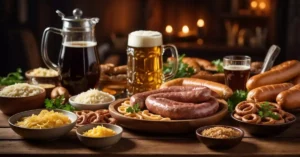Do you want to know what kids in Germany have for lunch at school? The subject of what German students eat during their lunch break is becoming increasingly interesting for parents concerned about their children’s dietary routines at school. In Germany, the school lunch constitutes a warm meal provided daily to the students.
The German school lunch program is designed to provide students with a balanced and nutritious meal that meets their daily dietary needs. The meals are usually prepared using fresh ingredients, and they are served in a cafeteria-style setting. Normally, Students have the option to choose from a variety of dishes, including vegetarian options. The meals are also priced affordable, making them accessible to all students. So it’s not a big surprise to find some of the most known German meals in the schools, as it is a part of the German Food culture.
The German school lunch program has received positive feedback from parents and students alike. It has been praised for its nutritional value, affordability, and variety of options. If you are interested in learning more about German school lunch, keep reading to find out about the different dishes that are served and the benefits of the program.
- The Cultural Significance of German School Lunch
- The German School Lunch System
- 5 Tasty German School Lunch Dishes to Try
- Health and Nutritional Aspects of German School Lunches
- Challenges and Innovations in the German School Lunch System
- How German School Lunches Compare Globally
- Our Opinion about German School Lunch
- FAQ about German School lunch
The Cultural Significance of German School Lunch
German school lunch is more than just a meal. It’s an important aspect of German culture that reflects the country’s values and traditions. In this section, we’ll explore the role of food in German culture, the importance of balanced and nutritious meals in German schools, and how German school lunch programs compare to those in other countries.
The Role of Food in German Culture
Food plays a central role in German culture. Germans take pride in their cuisine, which is known for its hearty, flavorful dishes. Traditional German foods like sausages, sauerkraut, and schnitzel are staples in many households. Germans also place a high value on eating together as a family or community, which is why meals are often seen as a time to connect and socialize.
Importance of Balanced and Nutritious Meals in German Schools
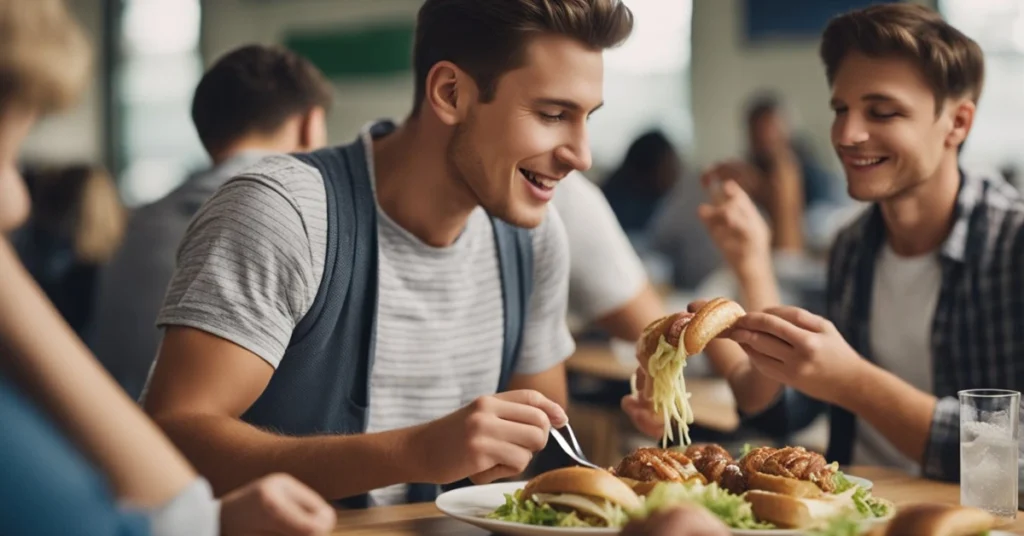
German schools place a strong emphasis on providing students with balanced and nutritious meals. According to The German Way & More, lunch tends to be the largest meal of the day for Germans. Schools allot time between 12 and 2 in the afternoon to have “mittagessen,” which is the German word for lunch. The meal typically consists of a main course, a side dish, and a dessert. Schools also offer a vegetarian option for students who don’t eat meat.
German school lunch programs are designed to provide students with the nutrients they need to stay focused and energized throughout the day. Schools work closely with nutritionists to ensure that the meals meet strict nutritional guidelines. For example, meals must contain a certain amount of protein, carbohydrates, and fiber. Schools also avoid using processed foods and instead opt for fresh, locally sourced ingredients.
Comparison with Other International School Lunch Programs
Compared to other countries, German school lunch programs are generally considered to be quite good. According to a report by Save Our Schools March, German schools offer a wider variety of foods than American schools, and the meals are generally healthier. German schools also tend to serve more vegetables and whole grains than schools in other countries.
The German School Lunch System
If you’re a student in Germany, you’re in luck when it comes to school lunch. The German School Lunch System is designed to provide students with healthy and nutritious meals during the school day.
Overview of The Structure of German School Lunches
In Germany, school lunches are typically served in a cafeteria-style setting, with students selecting their meals from a variety of options. The meals usually consist of a main dish, a vegetable or salad, and a dessert. Students can also choose from a range of beverages, including water, juice, and milk.
School Lunch Regulations and Guidelines in Germany
The German government has established strict regulations and guidelines for school lunches to ensure that students are receiving healthy and balanced meals. These regulations cover everything from the types of ingredients that can be used to the portion sizes of each meal. In addition, schools are required to provide vegetarian and halal options for students who require them.
Emphasis on Locally Sourced and Seasonal Ingredients
One of the unique aspects of the German School Lunch System is the emphasis on locally sourced and seasonal ingredients. Schools are encouraged to source their ingredients from local farmers and producers whenever possible, which not only supports the local economy but also ensures that the ingredients are fresh and of high quality. In addition, schools are encouraged to use seasonal ingredients, which helps to reduce the carbon footprint of the school lunch program.
5 Tasty German School Lunch Dishes to Try
So let’s get into the details. What are our favorites when it comes to German school lunch meals? German cuisine is known for its hearty and flavorful dishes that are sure to satisfy your hunger and taste buds. Here are five tasty German school lunch dishes that you should definitely try.
Dish 1: Kartoffelsalat (Potato Salad)

Kartoffelsalat is a classic German dish that is perfect for lunch. This dish is made with boiled potatoes, onions, and a tangy vinegar dressing. It’s a great side dish to accompany any main course or can be enjoyed on its own.
Dish 2: Schnitzel with Rotkohl (Breaded Meat Cutlet with Red Cabbage)

Schnitzel with Rotkohl is a popular German dish that consists of a breaded meat cutlet served with red cabbage. The meat is usually pork or veal, and it’s breaded and fried until crispy. The red cabbage is cooked with apples and vinegar to give it a sweet and tangy flavor.
Dish 3: Gemüse Maultaschen (Vegetable-filled Pasta Pockets)
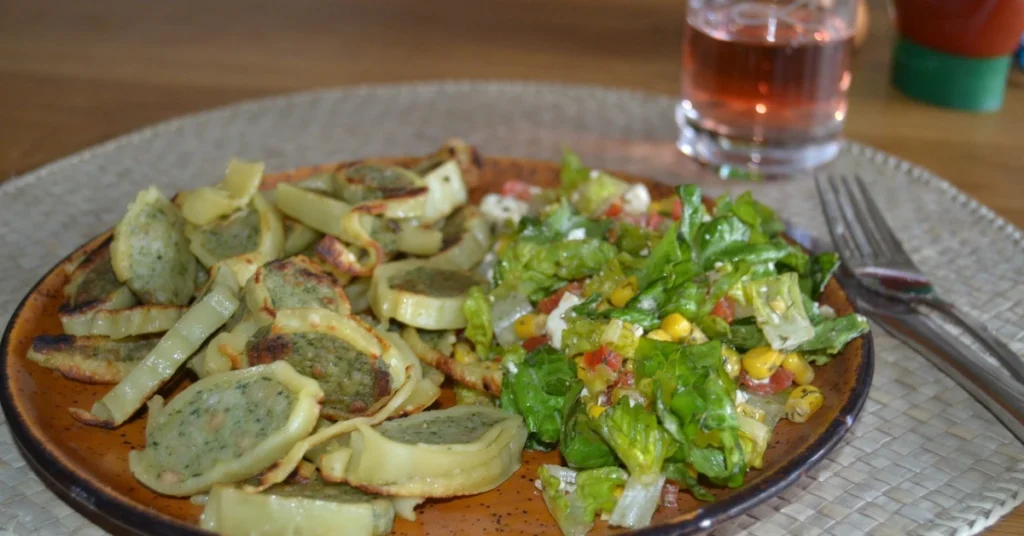
Gemüse Maultaschen is a vegetarian dish that is perfect for school lunch. It consists of pasta pockets filled with a mixture of vegetables and spices. The pasta pockets are then boiled and served with a creamy sauce. Maultaschen are very famous in South Germany, the Schwabenland in the first place.
Dish 4: Currywurst with Pommes (Curry Sausage with French Fries)

Currywurst with Pommes is a popular street food in Germany and is a great lunch option. The dish consists of a grilled sausage that is sliced and served with a curry ketchup sauce. It’s usually served with a side of French fries, known as Pommes in Germany. It is also known as one of the most famous German Snacks that is presented near to everywhere in the country.
Dish 5: Fischbrötchen (Fish Sandwich)

Fischbrötchen is a popular sandwich in Germany that is perfect for lunch. It consists of a fresh fish fillet served on a bun with lettuce, tomato, and a tangy sauce. It’s a great option for those who want a lighter lunch. Our favorite Fish Sandwich is with original Emder Matjes and Onion Rings. If you visit the northern part of Germany, you really got to try it.
Health and Nutritional Aspects of German School Lunches
As a student in Germany, you can expect to receive a healthy and well-balanced meal during lunchtime. German school lunches are designed to provide students with the necessary nutrients required for their growth and development. In this section, we will discuss the key health and nutritional aspects of German school lunches.
Focus on a Balanced Diet
German school lunches are carefully planned to ensure that they provide a balanced diet to students. The meals consist of a variety of food groups, including carbohydrates, proteins, and fats. The carbohydrates are usually derived from whole grains, while the proteins come from a variety of sources such as meat, fish, and legumes. Fats are also included in the meal, but in limited amounts.
Integration of Fresh Fruits and Vegetables
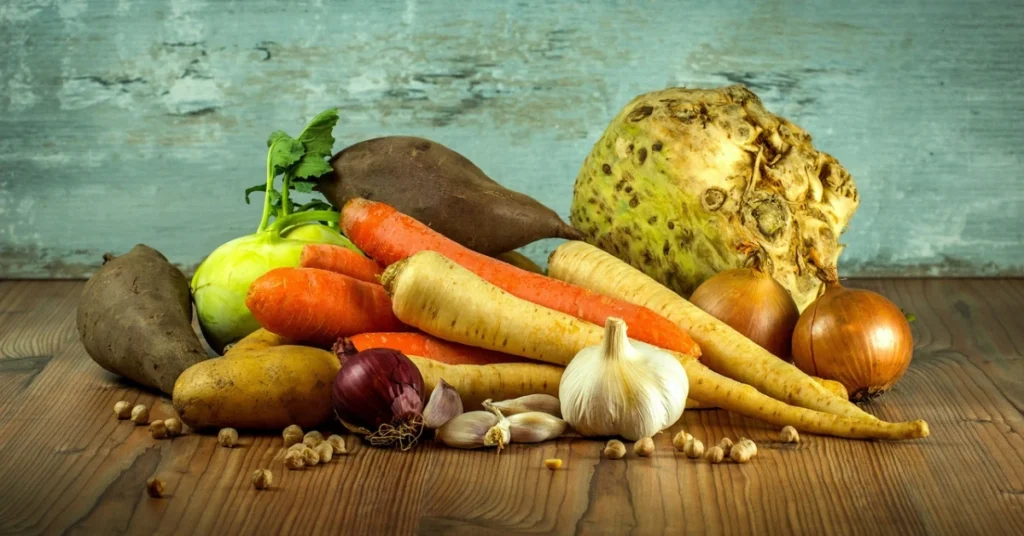
German school lunches place a strong emphasis on the inclusion of fresh fruits and vegetables. These are an essential part of a healthy diet and provide students with important vitamins and minerals. The fruits and vegetables are often served as a side dish or as a salad, and they are usually sourced locally to ensure freshness and quality.
Limited Processed Foods and Sugary Items
German school lunches limit the inclusion of processed foods and sugary items. Instead, the focus is on providing students with healthy and wholesome meals. This means that the meals are prepared using fresh ingredients and are free from additives and preservatives. Sugary items such as desserts and sweets are limited and are usually served in moderation.
In conclusion, German school lunches are designed to provide students with a healthy and well-balanced meal. The meals consist of a variety of food groups, including carbohydrates, proteins, and fats. Fresh fruits and vegetables are also an essential part of the meal. Additionally, the meals are free from processed foods and sugary items.
Challenges and Innovations in the German School Lunch System
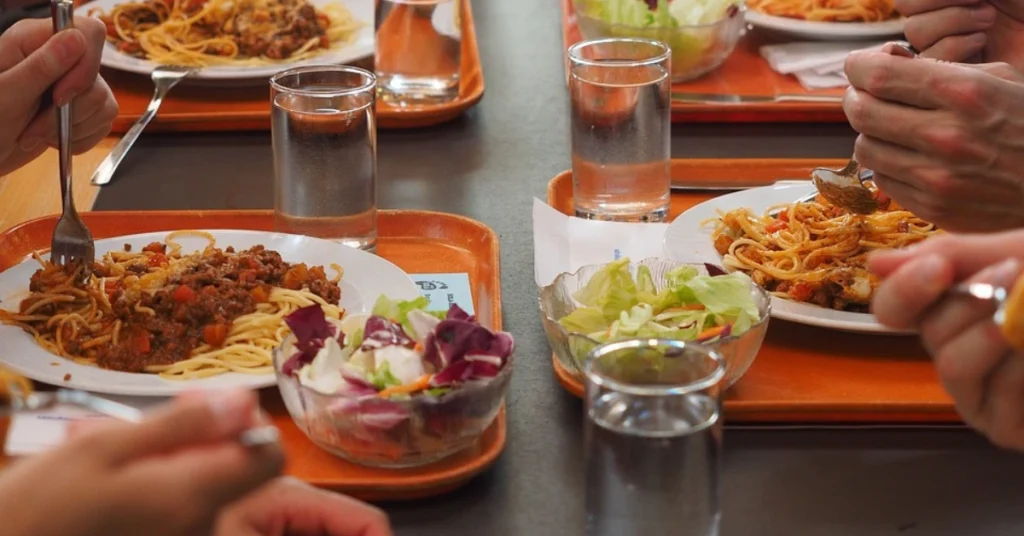
Are you curious about what German school children eat for lunch? The German school lunch system has undergone significant changes in recent years. The goal is to provide healthy and nutritious food to students while addressing challenges such as dietary restrictions, food waste, and nutritional quality.
Addressing Dietary Restrictions and Preferences
Many German schools are now accommodating dietary restrictions and preferences. For example, some schools offer vegetarian or vegan options, while others provide gluten-free or lactose-free meals. Students can also choose from a variety of meal options, such as soups, salads, and sandwiches. This ensures that students with different dietary requirements can enjoy a nutritious meal.
Initiatives to Reduce Food Waste
Food waste is a significant problem in many school lunch systems. However, German schools are taking steps to reduce food waste. Some schools have implemented a “no waste” policy, where students are encouraged to take only what they can eat. Others have started composting programs to reduce the amount of food waste that ends up in landfills.
Ongoing Efforts to Improve the Nutritional Quality of School Lunches
German schools are continually working to improve the nutritional quality of school lunches. Many schools have introduced healthier options, such as fresh fruits and vegetables, whole grains, and lean proteins. Some schools have also started working with local farmers to source fresh, seasonal produce. This ensures that students receive the best possible nutrition from their school lunches.
In conclusion, the German school lunch system has come a long way in recent years. With a focus on dietary restrictions and preferences, reducing food waste, and improving nutritional quality, German schools are providing healthy and nutritious meals to their students.
How German School Lunches Compare Globally
If you’re curious about how German school lunches compare with those of other countries, you’ll be interested in this section. Germany has a unique approach to school lunches that sets it apart from other countries. In this section, we’ll explore the contrasts with the school lunch systems of other countries and the lessons that can be learned and applied internationally.
Contrasts with the School Lunch Systems of Other Countries
In the United States, the typical school lunch follows a formula of starch, protein, and vegetables. Students can expect to find options like pizza, chicken nuggets, hamburgers, and hot dogs as the main protein source. In contrast, German school lunches tend to be healthier and more balanced. German schools serve a variety of dishes that include fresh vegetables, fruits, and whole grains. Meat is still a common protein source, but it is usually served in smaller portions.
In France, school lunches are seen as a part of the country’s cultural heritage. French school lunches are known for their high-quality ingredients, and students are often served dishes like ratatouille, salmon, and quiche. In Japan, school lunches are also seen as an important part of the education system. Japanese school lunches are known for their focus on balance and variety. Students are served a wide range of dishes that include rice, fish, vegetables, and soup.
Lessons That Can Be Learned and Applied Internationally
One of the key lessons that can be learned from Germany’s school lunch system is the importance of balance. German school lunches are designed to provide students with a balanced meal that includes all the necessary nutrients. This is an approach that can be applied internationally, as it ensures that students are getting the nutrients they need to stay healthy and focused.
Another lesson that can be learned from Germany’s school lunch system is the importance of fresh ingredients. German schools prioritize fresh, locally-sourced ingredients, which helps to ensure that students are getting the highest quality food possible. This is an approach that can be applied internationally, as it helps to support local farmers and promotes sustainable food production.
In conclusion, German school lunches are unique in their approach to providing students with healthy, balanced meals. By focusing on fresh ingredients and balance, Germany has created a school lunch system that can serve as a model for other countries around the world.
Our Opinion about German School Lunch
When it comes to German School lunch, you can say it’s the best from different worlds. You get a full meal, a healthy meal too and you don’t have to pay a bunch for it. It’s also a component of the reliable school system, in that the Kids can stay the whole day at school and the parents can widen out their working time.
The school lunch is also a part of the social education in Germany.
FAQ about German School lunch
Are school lunches in Germany free for all students?
Yes, in most German schools, lunch is provided for free or at a reduced cost for students from low-income families. If you earn on a regular basis, you have to pay for the food, but it is always more than affordable.
What types of food are commonly served in German school lunches?
Typical German school lunches include a variety of dishes such as schnitzel, sausages, potatoes, vegetables, and bread.
Do German schools accommodate dietary restrictions for students?
Yes, German schools often provide alternative meal options for students with dietary restrictions, including vegetarian and allergy-friendly choices.
So, do you have any experience with the German School food or the German School system? So please let us know and leave a comment down below to share your opinion with us.





